The Intel Comet Lake Core i9-10900K, i7-10700K, i5-10600K CPU Review: Skylake We Go Again
by Dr. Ian Cutress on May 20, 2020 9:00 AM EST- Posted in
- CPUs
- Intel
- Skylake
- 14nm
- Z490
- 10th Gen Core
- Comet Lake
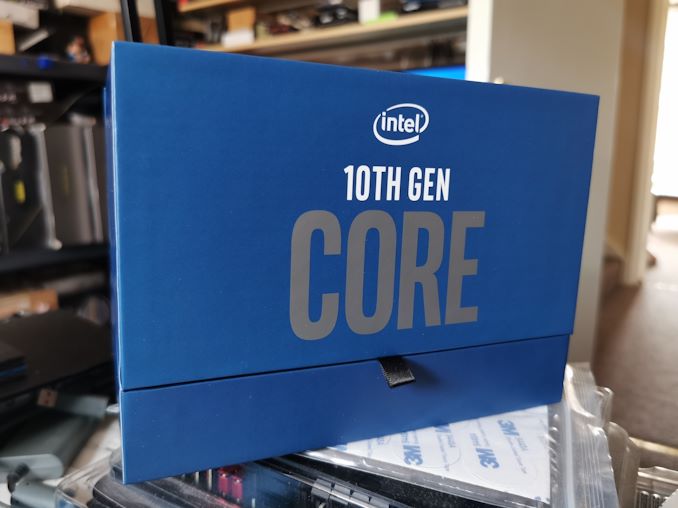
The first thing that comes to mind with Intel’s newest line of 10th Generation desktop processors is one of ‘14nm Skylake, again?’. It is hard not to ignore the elephant in the room – these new processors are minor iterative updates on Intel’s 2015 processor line, moving up from four cores to ten cores and some extra frequency, some extra security measures, a modestly updated iGPU, but by and large it is still the same architecture. At a time when Intel has some strong competition, Comet Lake is the holding pattern until Intel can bring its newer architectures to the desktop market, but can it be competitive?
Three weeks ago, Intel announced the Comet Lake 10th Generation Core processor family line for desktops. From Celeron and Pentium all the way up to Core i9 there were 32 new processor models, representing a sizeable offering to the market. The key elements to this range of processors was the introduction of 10 cores for the Core i9 parts at the high-end – an increase of two cores over the last generation – and the introduction of Intel’s Thermal Velocity Boost for Core i9 that enables +100 MHz in the cooler thermal environments.
The best processor from the range, the Core i9-10900K, promises 5.3 GHz peak turbo in optimal conditions for two preferred cores, or 4.9 GHz for all-core situations. Everything from Core i9, Core i7, Core i5, Core i3, and the Pentium Gold processors have hyperthreading, making the processor stack easier to understand for this generation. Compared to the previous generation, there are a lot of similar processor matchups, and except for the top 10-core parts, the offerings should move down one price bracket this time around.
Intel has changed the socket for this generation, moving to an LGA1200 platform. This also means there are new motherboards, the Intel 400 series family, including the Z490 chipset which has 44+ entrants ranging from $150 all the way up to $1200. We have a very thorough analysis of every motherboard in our Z490 motherboard overview.
The Processor Stack
As mentioned, there are 32 processors for the new Comet Lake 10th Generation Core family. The Core i9/i7/i5/i3 parts will broadly fall into four categories:
- K = Overclockable with Integrated Graphics, 125 W TDP
- KF = Overclockable but no Integrated Graphics, 125 W TDP
- F = No Integrated Graphics, 65 W
- T = Low Power with Integrated Graphics, 35 W
- No Suffix = Regular CPU with Integrated Graphics, 65 W
Intel uses these divisions based on both customer demand but also its ability to separate the best quality silicon from its manufacturing. Silicon that can enable low-power operation becomes T processors, while silicon that can push the highest frequencies at reasonable voltages becomes the K silicon. Some silicon might not be up to par with the integrated graphics, and so these become F processors, and are generally cheaper than the non-F versions to the tune of $11-$25.
Here is how these new processors stack-up.
| Intel 10th Gen Comet Lake Core i9 and Core i7 |
||||||||||
| AnandTech | Cores | Base Freq |
TB2 2C |
TB2 nT |
TB3 2C |
TVB 2C |
TVB nT |
TDP (W) |
IGP | Price 1ku |
| Core i9 | ||||||||||
| i9-10900K | 10C/20T | 3.7 | 5.1 | 4.8 | 5.2 | 5.3 | 4.9 | 125 | 630 | $488 |
| i9-10900KF | 10C/20T | 3.7 | 5.1 | 4.8 | 5.2 | 5.3 | 4.9 | 125 | - | $472 |
| i9-10900 | 10C/20T | 2.8 | 5.0 | 4.5 | 5.1 | 5.2 | 4.6 | 65 | 630 | $439 |
| i9-10900F | 10C/20T | 2.8 | 5.0 | 4.5 | 5.1 | 5.2 | 4.6 | 65 | - | $422 |
| i9-10900T | 10C/20T | 1.9 | 4.5 | 3.7 | 4.6 | - | - | 35 | 630 | $439 |
| Core i7 | ||||||||||
| i7-10700K | 8C/16T | 3.8 | 5.0 | 4.7 | 5.1 | - | - | 125 | 630 | $374 |
| i7-10700KF | 8C/16T | 3.8 | 5.0 | 4.7 | 5.1 | - | - | 125 | - | $349 |
| i7-10700 | 8C/16T | 2.9 | 4.7 | 4.6 | 4.8 | - | - | 65 | 630 | $323 |
| i7-10700F | 8C/16T | 2.9 | 4.7 | 4.6 | 4.8 | - | - | 65 | - | $298 |
| i7-10700T | 8C/16T | 2.0 | 4.4 | 3.7 | 4.5 | - | - | 35 | 630 | $325 |
| Core i5 | ||||||||||
| i5-10600K | 6/12 | 4.1 | 4.8 | 4.5 | - | - | - | 125 | 630 | $262 |
| i5-10600KF | 6/12 | 4.1 | 4.8 | 4.5 | - | - | - | 125 | - | $237 |
| i5-10600 | 6/12 | 3.3 | 4.8 | 4.4 | - | - | - | 65 | 630 | $213 |
| i5-10600T | 6/12 | 2.4 | 4.0 | 3.7 | - | - | - | 35 | 630 | $213 |
| i5-10500 | 6/12 | 3.1 | 4.5 | 4.2 | - | - | - | 65 | 630 | $192 |
| i5-10500T | 6/12 | 2.3 | 3.8 | 3.5 | - | - | - | 35 | 630 | $192 |
| i5-10400 | 6/12 | 2.9 | 4.3 | 4.0 | - | - | - | 65 | 630 | $182 |
| i5-10400F | 6/12 | 2.9 | 4.3 | 4.0 | - | - | - | 65 | - | $157 |
| i5-10400T | 6/12 | 2.0 | 3.6 | 3.2 | - | - | - | 35 | 630 | $182 |
| Core i3 | ||||||||||
| i3-10320 | 4/8 | 3.8 | 4.6 | 4.4 | - | - | - | 65 | 630 | $154 |
| i3-10300 | 4/8 | 3.7 | 4.4 | 4.2 | - | - | - | 65 | 630 | $143 |
| i3-10300T | 4/8 | 3.0 | 3.9 | 3.6 | - | - | - | 35 | 630 | $143 |
| i3-10100 | 4/8 | 3.6 | 4.3 | 4.1 | - | - | - | 65 | 630 | $122 |
| i3-10100T | 4/8 | 3.0 | 3.8 | 3.5 | - | - | - | 35 | 630 | $122 |
| Pentium Gold | ||||||||||
| G6600 | 2/4 | 4.2 | - | - | - | - | - | 58 | 630 | $86 |
| G6500 | 2/4 | 4.1 | - | - | - | - | - | 58 | 630 | $75 |
| G6500T | 2/4 | 3.5 | - | - | - | - | - | 35 | 630 | $75 |
| G6400 | 2/4 | 4.0 | - | - | - | - | - | 58 | 610 | $64 |
| G6400T | 2/4 | 3.4 | - | - | - | - | - | 35 | 610 | $64 |
| Celeron | ||||||||||
| G5920 | 2/2 | 3.5 | - | - | - | - | - | 58 | 610 | $52 |
| G5900 | 2/2 | 3.4 | - | - | - | - | - | 58 | 610 | $42 |
| G5900T | 2/2 | 3.2 | - | - | - | - | - | 35 | 610 | $42 |
The Core i9 and Core i7 processors will support DDR4-2933, while everything else supports DDR4-2666. These processors are all PCIe 3.0, with sixteen lanes from the CPU available for add-in cards and direct connected storage. Intel likes to point out that they offer another 24 PCIe 3.0 lanes on the chipset, however the uplink to the processor is still a DMI/PCIe 3.0 x4 link.
As far as we understand, Intel will be coming to market first with the K processors, and the other processors should be a quick follow-on. That being said, a large number of Intel’s Core 9th Gen processor line have been difficult to obtain at retail as the company sees record demand for its server processors. As those command a higher operating margin, Intel would rather spend its manufacturing resources making those server processors instead, leading to shortages of the consumer mainline CPUs. Even as a primary reviewing technology media organization focusing on companies like Intel, Intel has not proactively sampled the media with many of the 9th Generation parts - perhaps the lack of availability is one of those reasons. It will be interesting to see how many of the Intel 10th Gen processors are made available to both reviewers and the public alike.
For this review, we were able to obtain the 10-core Core i9-10900K, the 8-core Core i7-10700K, and the 6-core Core i5-10600K.
Getting Complicated with Turbo
In the charts above, we have multiple different levels of ‘turbo’ for every processor. Intel loves to talk turbo in the sense of offering performance, however it can get complicated about which levels of turbo apply at any given time. Turbo Boost 2, Turbo Boost Max 3.0, and Thermal Velocity Boost without context make very little sense to anyone not necessarily au fait with the world of computer processors. To break it down:
- Base Frequency: Minimum guaranteed frequency at any time
- Turbo Boost 2.0: A potential upper limit frequency that all cores can achieve at any time
- Turbo Boost Max 3.0: Also known as Favored Core, this is a peak frequency that two select cores can achieve at any time
- Thermal Velocity Boost: A new upper limit mode frequency where all cores can gain +100 MHz if the processor temperature is below a given limit, including favored cores in TBM3 mode
- Favored Core: Up to two cores per processor are selected as the cores that provide the best voltage-to-frequency-to-power response, making them the best candidates for additional turbo frequency
With these definitions in mind, we can go through each of the different turbo modes into some level of specificity:
- Base Frequency: The guaranteed frequency when not at thermal limits
- Turbo: A frequency noted when below turbo power limits and turbo power time
- All-Core Turbo: The frequency the processor should run when all cores are loaded during the specified turbo time and limits
- Turbo Boost 2.0: The frequency every core can reach when run with a full load in isolation during turbo time
- Turbo Boost Max 3.0: The frequency a favored core can reach when run with a full load in isolation during turbo time
- Thermal Velocity Boost: The +100 MHz boost given to a core when run with a full load and is below the specified temperature (70ºC for Comet Lake) during turbo time
- Intel TVB All-Core: The frequency the processor should run when all cores are loaded during the specified turbo time and limits and is below the specified temperature (70ºC for Comet Lake) during turbo time
Even when speaking with a number of my industry peers, the way this has all been described makes it very complex and difficult to explain to each other sometimes, let alone non-technical users. It can be quite complex to explain to a friend why they are not seeing the maximum turbo frequency on the box for their system due to specified thermal windows that are not being achieved, or why the turbo might not last as long.
For the case of the Core i9 parts, Intel’s Thermal Velocity Boost (TVB) limits for the i9-10900K are 5.3 GHz single core, 4.9 GHz all-core, and after the turbo budget is used, the CPU will operate somewhere above the base clock of 3.7 GHz. If the processor is above 70ºC, then TVB is disabled, and users will get 5.2 GHz on two favored cores (or 5.1 GHz for other cores), leading to 4.8 GHz all-core, until the turbo budget is used and then back to somewhere above the base clock of 3.7 GHz.
With all these qualifiers, it gets very complicated to understand exactly what frequency you might get from a processor. In order to get every last MHz out of the silicon, these additional qualifiers mean that users will have to pay more attention to the thermal demands of the system, airflow, but also the motherboard.
As explained in many of our other articles, motherboard manufacturers have the option to disregard Intel’s turbo limit recommendations completely. This cannot be overstated enough – at least one of my colleagues had issues with a motherboard implementing a different turbo profile than Intel’s suggested recommendations. This is because with an appropriately built motherboard, a manufacturer might enforce an all-core 5.1-5.3 GHz scenario with the i9-10900K, regardless of the temperature, for an unlimited time – if the user can cool it sufficiently. Intel states that the Core i9-10900K has a peak turbo power around 250 W, however motherboard manufacturers earlier this year told us they were building boards for 320-350 W turbo power to give additional thermal headroom or in the event that the 250 W suggestion is completely ignored. Choosing a motherboard just got more complex if a user wants the best out of their new Comet Lake processor.
For example, here is an output from our y-Cruncher test, which uses an AVX2 optimized code path. We see that the Core i9-10900K boosts uses up to 254 W at peak moments, but through the whole test it uses 4.9 GHz for ~175 seconds. Intel's turbo has a recommended length of 56 seconds according to the specification sheets, and on our test system here, the motherboard manfuacturer is confident that its power delivery can support a longer-than-56 second turbo time. This is all above board according to Intel, as they recommend that motherboard vendors apply what they think is best for the product they have built. It only becomes out of specification if an overclock is applied - Intel does not consider this an overclock.
Beyond the standard Core i9 parts, it’s worth pointing out the low power processors, such as the Core i9-10900T. This processor has a TDP of 35 W, and a base frequency of 1.9 GHz, but can turbo all cores up to 3.7 GHz. Here’s a reminder that the power consumed while in turbo mode can go above the TDP, into the turbo power state, which can be 250 W to 350 W. I’ve asked Intel for a sample of the processor, as this is going to be a key question for the chips that have a strikingly low TDP.
It’s worth noting that only the Core i9 parts have Intel Thermal Velocity Boost. The Core i7 hardware and below only have Turbo Max 3.0 ‘favored core’ arrangements. We’ve clarified with Intel that the favored core drivers have been a part of Windows 10 since 1609, and have been mainlined into the Linux kernel since January 2017.
With the F processors, the ones without integrated graphics, the price saving seems to be lower for Core i9 than for any other of Intel’s segments. The cost difference per-unit between the 10900K and 10900KF is only $16, whereas the 10700 and 10700F is $25.
This Review
For this review, we managed to secure three processors for testing: the Core i9-10900K, the Core i7-10700K, and the Core i5-10600K. These three 125 W processors represent the overclocking parts from each of the main categories (there is no overclockable Core i3 this generation).
We tested all three processors in the ASRock Z490 PG Velocita, and the only serious issue experienced was an error completely on my part – I got fluff in the socket when changing processors. The ASRock board and all three CPUs cruised through our test-suites.
All three CPUs are based on the 10 core silicon dies (more on the next page), which lead to some interesting core-to-core latencies which we’ll go into. Unlike some of Intel’s previous parts, we had no issues hitting the Thermal Velocity Boost on the Core i9-10900K, as show in the CPU-Z screenshot with 5.3 GHz being registered. It does look like that most motherboards are ignoring Intel’s TVB completely, and making those numbers the new Turbo Boost Max 3.0 – both our system and our colleagues at other Future publications saw similar with their motherboards tested.
Elephant in the Room
As mentioned, 10th Gen Comet Lake is, by and large, the same CPU core design as 6th Gen Skylake from 2015. This is, for lack of a better explanation, Skylake++++ built on 14++. Aside from increasing the core count, the frequency, the memory support, some of the turbo responses, and enabling more voltage/frequency customization (more on the next page), there has been no significant increase in IPC from Intel all while AMD has gone from Excavator to Zen to Zen 2, with sizable IPC increases and efficiency improvements. With Intel late on 10nm, Comet Lake does feel like another hold-over until Intel can either get its 10nm process right for the desktop market or backport its newer architectures to 14nm; so Intel should be trying its best to avoid a sixth generation of the same core design after this. Comet Lake is still aiming to carve a spot in the market, with the main marketing materials from Intel promising the best gaming experience.
Despite Intel telling us over the previous years that ‘mega-tasking’ is the new buzzword for demanding software running simultaneously on an enthusiast system, with Comet Lake the messaging is back to one purpose – offering the best single-threaded gaming experience. We know that AMD’s Zen 2 has as a slight 10-15% IPC advantage over 9th Gen Coffee Lake, so it will be interesting to see if Intel’s 10% peak frequency advantage affords many benefits. We’ll be keeping an eye on that power consumption too, something that Intel users have chastised AMD hardware for in the past.


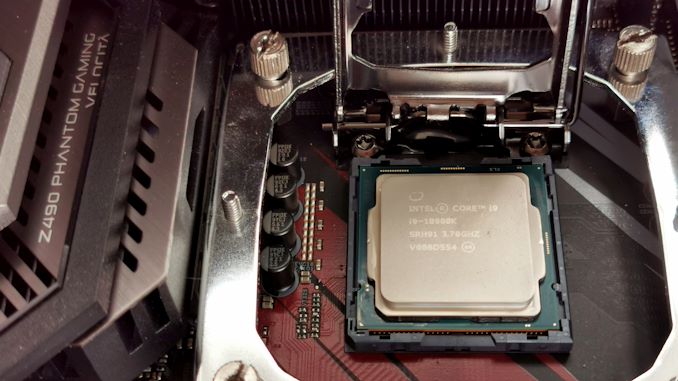
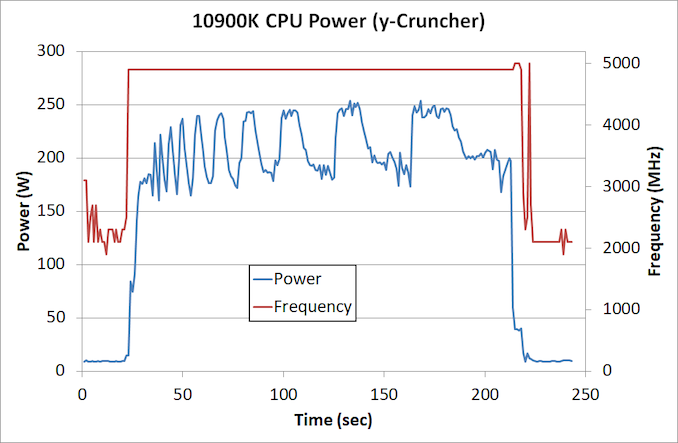
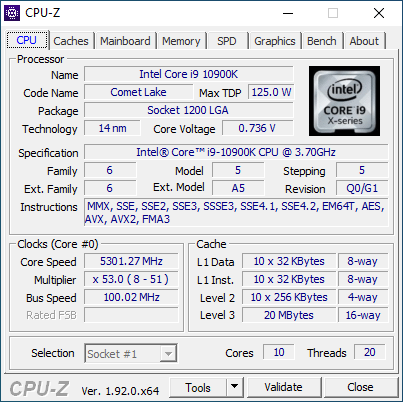

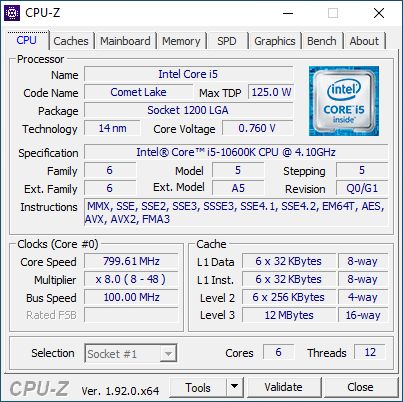
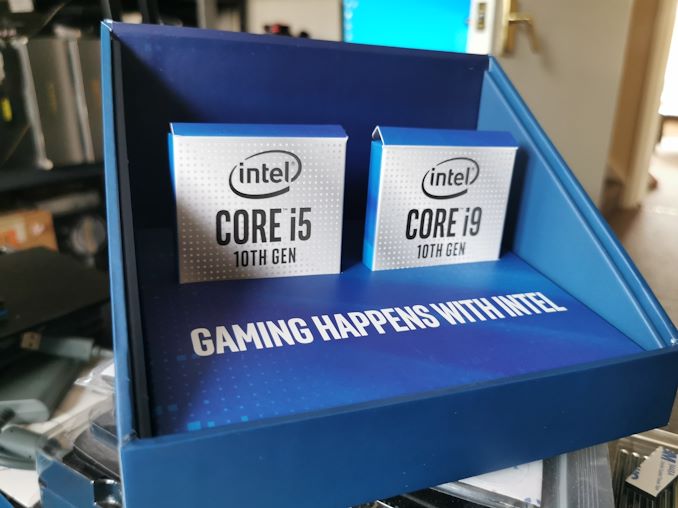








220 Comments
View All Comments
DrKlahn - Wednesday, May 20, 2020 - link
My biggest issue with gaming is that these reviews rarely show anything other than low resolution scenarios. I realize a sizable slice of the gaming community uses 1080p and that some of them are trying to hit very high frame rates. But there also a lot of us with 1440p+ or Ultrawides and I think it gets overlooked that Intels gaming "lead" largely evaporates for anyone not trying to hit very high frames at 1080p.ElvenLemming - Wednesday, May 20, 2020 - link
Honestly, I think it's ignored because it's well understood that at 1440p+ the CPU just doesn't matter very much. There's not much value in anything above 1080p for a CPU review the vast majority of games are going to be GPU limited. That said, plenty of other outlets include them in their reviews if you want to see a bunch of charts where the top is all within 1% of each other.DrKlahn - Wednesday, May 20, 2020 - link
I do agree with you that a lot of us do understand that as resolution and detail increases, CPUs become almost irrelevant to gaming performance. However you do see a fair few posters parroting "Intel is better for gaming" when in reality for their use case it really isn't any better. That's why I feel like these reviews (here and elsewhere) should spotlight where this difference matters. If you are a competitive CS:GO player that wants 1080p or lower with the most frames you can get, then Intel is undoubtedly better. But a person who isn't as tech savvy that games and does some productivity tasks with a 1440p+ monitor is only spending more money for a less efficient architecture that won't benefit them if they simply see "Intel better for gaming" and believe it applies to them.shing3232 - Thursday, May 21, 2020 - link
3900X or 3800X can beat Intel 9900Kf on csgo with pbo on if I remember correctly.silencer12 - Saturday, May 23, 2020 - link
Csgo is not a demanding gamevanilla_gorilla - Monday, June 15, 2020 - link
>If you are a competitive CS:GO player that wants 1080p or lower with the most frames you can get, then Intel is undoubtedly better.It's actually more complicated than that. Even midrange Zen 2 CPU can hit well over 200 fps in CS:GO. So unless you have a 240hz monitor, it won't make any difference buying Intel or AMD in that case.
Irata - Wednesday, May 20, 2020 - link
Techspot shows a seven game average and there the avg fps / min 1% difference to the Ryzen 3 3300x is less than 10% using a 2080ti.CrimsonKnight - Thursday, May 21, 2020 - link
This review's benchmarks goes up to 4K/8K resolution. You have to click the thumbnails under the graphs.Meteor2 - Wednesday, July 15, 2020 - link
To be clear: Anandtech tests at low resolutions so the bottleneck is the CPU, not the GPU. A Ryzen 5 won’t bottleneck a 2080 Ti at 4K.kmmatney - Wednesday, May 20, 2020 - link
Those of us who live near a Microcenter can get the 3900X for $389, along with a $20 discount on a motherboard (and a serviceable heatsink). The Ryzen 5 (what I bought) is $159, also with a $20 motherboard discount and a decent cooler. So my effective motherboard cost was $79, and total cost of $240 + tax, with a motherboard that can (most likely) be upgraded to Zen 3